| Home Page | Previous | Next | Guestbook |
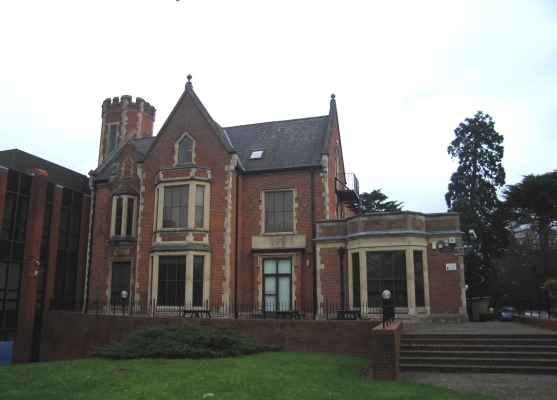
The History of Springfield House
(1856–2016)
William George Nixey bought the Old Vicarage at Slough in 1856, and built Springfield House on the site. His home, it’s believed, was named after the spring of water found there. His nickname, “the Blacklead King,” led to the building being known locally as “Blacklead Castle.”
The earliest mention I’ve found so far of the name “Springfield House” was on 10th March 1860, when it was given as the birthplace of William George and Charlotte Nixey’s youngest child, Clara Burnell. Later the same year, the Windsor and Eton Express of Saturday 11th August printed the following article:
|
SLOUGH |
When the 1861 Census was taken on the night of 7th April, William George and Charlotte Nixey’s address was simply given as Upton, but as their daughter Clara Burnell was born at Springfield House the previous year, it’s safe to say this was their home at the time of the Census (Ref: RG09 Piece 853 Folio 63 Page 20). Living with them were their children Charlotte Elizabeth (aged 14), Marie Anne (aged 11), Jessie (aged 9), William George (aged 6), Augusta (aged 3), and Clara Burnell (aged 1). They also had three servants, Margaret Hilder, Hannah Humphries, and Amie Gardener, and Louisa Phillips was visiting the family. The census enumerator’s description page gives the following details of the area where Springfield House was located:
|
Part of the Parish of Upton, including Upton Park (the Upper and Lower Lodges excepted), the Village of Upton, Upton Court Farm, the Houses on both sides of Upton Lane leading to the Bath Road, Morecraft’s cottage, and all Houses south of the Bath Road to the Eagle Tavern, including Grove Road, Alpha Road, Russell Terrace and the east side of Upton Park Road, Eton Villas, Beaumont and Claremont Places and Upton Park Terrace, all in Town of Slough. |
|
“WANTED, a good PLAIN COOK, middle age; able to undertake a small dairy. Apply by letter, stating character, &c., at Springfield House, Upton, Slough, Bucks.”–Windsor and Eton Express, Saturday 29th August 1868 “WANTED, a Good Plain COOK, for the country; age 30 to 35; must be very clean and a good manager; a small dairy; help after one o’clock; a good personal character. C. N., Springfield House, Slough.”–London Evening Standard, Friday 19th September 1879 |
The first census that Springfield House was named in was in 1871, the head of house being William George Nixey’s widow, Charlotte née Pitt (Ref: RG10 piece 1401 folio 88 page 53). Living with her were her children, Marianne (aged 21), Jessie (aged 19), William George (aged 16), Augusta (aged 13), and Clara Burnell (aged 11). Also with them were four servants, Hannah Walston, Mary A Horne, Hephsibah Blackall, and Eliza Atkins, and a visitor named Mary Burton.
The Nixey family were still resident at Springfield House when the 1881 census was taken on the night of 3rd April (Ref: RG11 piece 1460 folio 38 page 2). The head of house was Charlotte Nixey, and her son William George, whose occupation was recorded as “Black Lead Manufacturer”, was with her. Also living there was her daughter Augusta, as well as her three Chown grandchildren, and seven servants, Caroline Smith, Harriet Spiers, Hannah Wild, Elizabeth Foster, Kate V Dunn, Elizabeth Horne, and Jane E Hitchcock.
If you’ve ever wondered how large Springfield House was, how many rooms it had, and how extensive the land was where it was located, then wonder no more! Following the death of Charlotte Nixey née Pitt on 25th November 1889, this article was printed in the Friday 18th July and Saturday 26th July 1890 issues of the Morning Post, and it also appeared in the London Evening Standard of 10th September:
|
Near Datchet and Eton College.-The Charming FREEHOLD RESIDENTIAL ESTATE, known as Springfield, Slough, comprising a family residence, containing five reception-rooms, billiard-room, 11 bed-rooms, one dressing-room, bathroom, and ample domestic offices, standing in beautifully matured grounds of nine and a half acres, is for SALE, at half its original cost. Full particulars of Messrs. Beal, Son, and Chartres, auctioneers, 20, Regent-street, London, S.W. |
|
“George Wheatley, Ernest and Alfred Purser, and William Ebbs, boys, were charged on remand with stealing strawberries belonging to the trustees of the late Mr. Nixey, from ‘Springfield’, Bath-road. As there was nothing else against them they were let off with a caution.”–Bucks Herald, Saturday 30th July 1892 |
Springfield House was recorded as “uninhabited” at the time of the 1891 census (Ref: RG12 piece 1135 folio 60 page 56). It had still not been sold by the summer of 1892, but at some point during the next seven years it was renamed “Upton Towers,” and at this point, William John Herbert and his family had moved in. He had set up the well-known Herbert’s Supply Stores at 34-36 High Street, Eton, in the early to mid 1870’s. In 1890, Herbert’s Supply Stores Ltd was formed to take over, carry on, and extend the business which had rapidly developed. It was one of the largest and most complete stores outside of London. William’s object in forming the business into a limited company was to extend its operations and give his customers the opportunity of sharing in the profits, as there was a considerable scope for a large extension of the business. The price for the entire properties, including the large stock, plant, machinery, buildings, horses, vans, harness, fixtures, fittings, shop furniture of every description, the extensive leasehold premises and valuable good will was £28,000. Arrangements were made with William J Herbert by which his services as Managing Director were secured to the Company for a period of five years, and without salary, until the Shareholders had received a dividend each year of 5 percent, per annum. (These details were extracted from the Reading Mercury of Saturday 14th June 1890).
|
“Situations Vacant |
According to The Reading Mercury of Saturday 23rd September 1899, Florence Maud Herbert, the eldest daughter of William John Herbert, of Upton Towers, Slough, was married at Upton church on the 14th September. Her groom was Benjamin Ward Frost of Regent’s-park-road, N.W. He was the third son of George Bland Frost. They were married by the Rev. Stephen Tahourdin, the Minor Canon of St. George’s Chapel, Windsor.
Count Franz Otto Bubna, his wife Bertha and their son Egon, and Franz’s brother Charles, all of whom were born in Austria, were living at Upton Towers on the night of 31 March 1901 when that year’s census was taken (Ref: RG13 piece 1343 folio 76 page 1). Also with them were eight servants, Johann Einod, Mathilda Vitroet, Maria Urdl, Florence Strange, Alice Burdett, Annie Cooper, Emily Dutton, Ethel Ward, and two visitors, Mcculloch Bopp and Ernest Breisach. Shortly after that census, the Manchester Courier of Friday 28th June made the following announcement:
|
At the Roman Catholic Church, Slough, yesterday, Miss Irene May Blair, daughter of the Dowager Duchess of Sutherland, was married to Count Johann Franz Bubna, son of Count Bubna, of Upton Towers, Slough. The church was crowded with friends and relatives. |
When the 1911 census was taken on the night of 2nd April, the head of house at Upton Towers was H. Yourkivitch, although he signed the schedule as “Yourkevitch” (Ref: RG14 piece 7845 schedule 195). With him were his wife, H H Princess S Yourkivitch, their eight servants, W. Goodyear, A. Roberts, J. Belwood, M. Lucocke, F. Batchelor, J. Jacobs, V. Dawson, A. Odell, two visitors, H. G. Duc of Sasso Ruffo, Mrs. de Vronsky, and a friend, Miss James.
The following three schedules in the 1911 Census are all recorded as Upton Towers Lodge, presumably referring to the three cottages within the grounds. Living in the first cottage is John Henry Dean, whose birthplace is said to be Stainforth Doncaster Yorks, his occupation being recorded as “Coachman Domestic” (Ref: RG14 piece 7845 schedule 196. With him is his wifeAda née Belwood, and their two sons, John William and Belwood Arthur. Living in the second cottage is Marins Delpas and his wife Augustine Rolin, both having been born in France (Ref: RG14 piece 7845 schedule 197). Marins’ occupation is given as “Cuisinier,” (or Chef), while his wife is said to be a “Cravatiere,” (or tie-maker. In the third cottage are Valiny Sicre and his wife Jeanne, both having been born at Paris, France (Ref: RG14 piece 7845 schedule 198). Valney’s occupation is recorded as a “Valet (Domestic).”
It was just a little over two weeks following this Census that His Grace the Duke of Sasso Ruffo died on 15th April at Upton Towers, he was aged sixty-four.
The Sheffield Evening Telegraph of Tuesday 2nd July 1912 published an article entitled “Egyptian Princess Pressed for Money” which stated:
|
A dispute in respect of the proceeds of the sale of certain furniture acquired from Count Yourkevitch and his wife for £2,000, and the cost of a visit to Paris, came to-day before a King’s Bench Divisional Court upon an appeal by Messrs. Harding, butchers, of Slough, from an order made in Chambers by Master Darg. |
The following year, the Bucks Herald in its issue of Saturday 7th June 1913 advertised the auction of Upton Towers, in which some additional details and specific measurements were included:
|
Sales by Auction |
According to “‘The Fourth Battalion The King’s Own Regiment and the Great War’ – Notes Compiled by Lieut.-Col. W. F. A. Wadham” (published in 1920), in early August of 1914 the Battalion was stationed in Ulverston. On pages 9 and 10 it then gave details of their next assignment, and the places to which the Battalion were located:
|
On the 15th August orders were received (at 2.45 a.m.) to move to Slough for the purpose of guarding the Main Line of the Great Western Railway, between Paddington and Maidenhead. The Battalion left Ulverston on the 15th, in two trains (the first at 10-30 a.m. and the second at 12 noon), and arrived at Slough at 7-30 and 10-30 p.m. respectively. The second train was delayed owing to one of the horse boxes falling to pieces at Crewe, thereby causing serious injuries to the animals it contained, and our first casualty, one of the horses being so seriously damaged that it had to be shot. On arrival at Slough the Battalion was billeted in various schools for the night, and the following morning divided up by Companies. These were distributed amongst the different stations on the length of line – from Paddington to Twyford – allotted to the Battalion. Headquarters were established at Slough, in a large empty house with spacious grounds surrounding it, which quickly acquired the soubriquet of “Black Lead Castle,” owing to one of its former occupants having rejoiced in the name of Nixey. A black cat, “which went with the place,” succeeded to the title of the former occupant. At the stations along the line the officers and men were accommodated in the waiting rooms, without bedding, furniture, or comforts of any description, and lived in these comfortless places for rather more than three months, during which period the Battalion was carrying out the duties of patrolling the line and guarding the bridges, etc., their food being sent through from Slough in dixies. |
|
Slough Urban Council |
An article under the heading “Buckinghamshire Naval and Military War Pensions Committee” appeared in the Bucks Herald of Saturday 27th July 1918. It stated that Alderman Dr. West had reported that “considerable progress had been made since the last report in the provision of a Home in Bucks for totally disabled sailors and soldiers. A large house and gardens known as Upton Towers, Slough, had been acquired. H.R.H. Princess Alice had been elected chairman of the Provisional Committee, and was actively promoting the scheme, which also had the hearty approval of the Pensions Ministry, whose financial support so far as maintenance was concerned was in course of arrangement, but it was essential that the initial capital outlay should be found by voluntary effort, and a minimum sum of £10,000 was asked for. Princess Alice had received donations from Their Majesties the King and Queen, and already a considerable portion of the sum asked for had been subscribed. Though the Home, which would be called the Princess Alice Home for Totally Disabled Sailors and Soldiers, was not confined to Bucks men, being situated in the county it was specially convenient, and it was hoped that Bucks people would liberally support the scheme by their donations. The idea was to start with 20 beds, and as means were available to extend to 50 beds.”
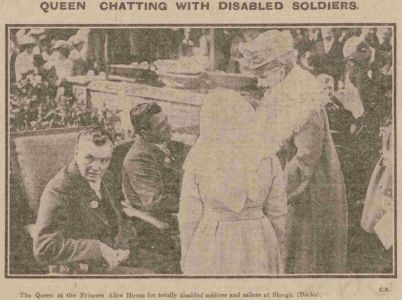
In the Bucks Herald of Saturday 26th April 1919, the following announcement was made:
|
Her Majesty The Queen will open the Princess Alice Home for Totally Disabled Sailors and Soldiers on Monday, May 5. The mansion which has now become a “Home” was formerly known as Upton Towers, and previously as Springfield, the home of the late Mr. W. G. Nixey, of blacklead fame." |
Below are excerpts from pages 5 and 7 of the Reading Standard of Saturday 10th May 1919, detailing the opening of the Princess Alice Home for Totally Disabled Sailors and Soldiers at Slough by Her Majesty the Queen on Monday 5th May 1919:
|
PRINCESS ALICE HOME FOR TOTALLY DISABLED SAILORS AND SOLDIERS SPLENDID FINANCIAL SUPPORT 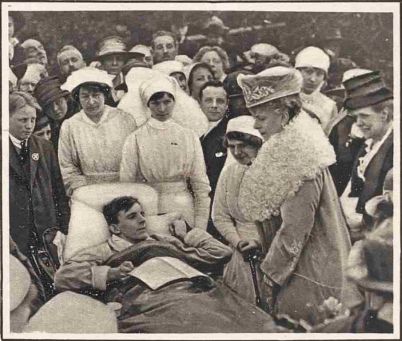
THE QUEEN OPENS THE PRINCESS ALICE HOME |
At the time this was printed, the result of the appeal was a total of £17,031 8s. 11d.
When the 1921 Census was taken, the person making the Census return for the Princess Alice Home for Disabled Sailors and Soldiers was the “Hospital Matron,” Emily Powers. Emily was said to be married, forty-six years eleven months old, and born at Stamford in Lincolnshire. Her employer was recorded as “The Governing Body, Princess Alice Home For Totally Disabled Soldiers & Sailors, Slough Bucks.” According to the Census return, there were thirty-four patients in residence on the night of 19th June 1921.
Individual entries from the 1921 Census have also been found for each of the three cottages located in the grounds, each being said to consist of four rooms. Living in the first cottage was Albert Valentine Suttling, an out-of-work Engineers Fitter, who was born at Mile End, London (Ref: RG15 piece 7313 schedule 60). With him were his wife Ethel May née Notton, and their four children, Vera Joan, Doris Olga, Nester Irene, and Leslie Graham. Living in the second cottage was Frank Kay, a Painter who had been born at Windsor in Berkshire (Ref: RG15 piece 7313 schedule 61). With him were his wife Alice née Harrison, and their two sons, Arthur Thomas, and George Frederick Harrison. Finally, living in the third cottage was Herbert George Steer, a “Fitters Labourer (Mechanic)” with the Slough Trading Company, who had been born at Bideford in North Devon (Ref: RG15 piece 7313 schedule 62). With him were his wife Jessie née Grace, and their two sons, Leonard George, and Herbert Granville.
Also in the 1921 Census, living at 23 Diamond Road in Slough, is George Peagam, who was born at Romansleigh in Devon (Ref: RG15 piece 7311 schedule 35). His occupation is recorded as “Handyman (Messrs. Langley & Johnson, Upton Towers, Slough, Bucks, Road & SewerContractors.” Living with him were his wife, Minnie née Bull, and their daughter, Doris Clara.
The Bucks Herald in its issue of Saturday 9th December 1922, under the heading “Princess Alice at Slough”, reported:
|
Princess Alice, Countess of Athlone, visited Slough on Friday, and assisted at a sale of work at her home for disabled sailors and soldiers. The work consisted of baskets and leather goods made by the patients. |
In 1938, it was decided to close the home for disabled soldiers and sailors, as announced in The Times of Saturday 13th August of that year:
|
Princess Alice Home to be Closed |
|
“Upton Towers, east of the bend on Upton Road, is an exuberantly turreted mid-Victorian house, originally named Springfield, which was built on the site of the old vicarage in 1856. It is now owned by the Slough Borough Council and is leased to the Bucks county Council as an old peoples home.”–The History of Slough, by Maxwell Fraser, 1973, p.144 |
On the night of 29th September 1939, which was National Registration Night, the address of the Princess Alice Nursing Home was given as Sussex Place, Slough, and there were doctors, matrons, midwives, and domestic servants recorded there. Many women were also listed, evidently the expectant and new mothers. The administrative head was Ethel Elizabeth Buchanan, who was born on 17th November 1897, who was described as “Princess Alice Maternity Home Commandant”. The head doctor was Ernest W. Bowskill, who was born on 11th September 1881. Following the end of the second world war, it was leased to Buckinghamshire Council for use as an old people’s home.
A report from part of a Bucks County Council meeting appeared in the Bucks Herald in the issue dated Friday 30th November 1945. The subject was the Future of Aylesbury, Amersham and Slough Emergency hospitals. It stated:
|
The Public Assistance Committee reported that during the period 1939/41 the Council leased to the Ministry of Health land belonging to the institutions at Aylesbury, Amersham and Slough for terms of 25 years, at nominal rents, to enable the Ministry to provide some 670 emergency medical service beds in hutments erected thereon. The committee had since administered those beds on behalf of the Government, as well as an annexe to the Slough Institution situated at Upton Towers, Slough. The future of these beds had recently been discussed with officers of the Ministry of Health, who stated that on the expiration of the leases of the land in some 20 years’ time the Council would become the owners of all the hutments, and that, if and when the need for emergency medical beds ceased earlier, the huts would be offered to the Council at a rent of four per cent on their capital cost, with a view to their becoming available for hospital services. The committee felt that the Council should be prepared to take over, on terms to be agreed, the emergency medical service huts attached to the three institutions when they cease to be required by the Ministry, so that they continue to be used as general hospitals. |
In 1977 the property began to be used for housing homeless families, and a few years later in 1980, consent was given for it to be used as offices. However, as a result of planning delays, the building stood empty for a number of years, and had subsequently suffered from vandalism.
The poet and language expert, Keith Bosley, who was born about nine miles from Slough at Bourne End, published a collection of his poems in 1987 with Anvil Press Poetry under the title “A Chiltern Hundred.” The poem below, “Blacklead Castle,” which was included in this book, is Copyright and appears by kind permission of Carcanet Press:
|
Blacklead Castle Blacklead Castle the name top-hatted neighbours called dreamed and built by a man richer than they, who mined Blacklead Castle today still is a dream of home dozing slumped in the State their benefactor's house while their tea trolley comes loaded with little cups Moulded ceilings resound when a tin tray is dropped |
In 1998, Upton Towers was recorded as being used as offices, the building was later extended, and the resulting office block was renamed “Elvian House”.
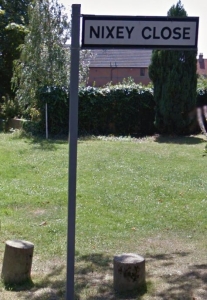
The Slough Express of Sunday 18th December 2011 printed an article written by Laura Enfield under the title, “Landmark Building Destroyed by Fire”:
|
A landmark building was badly destroyed by fire on Friday night. |
On 21st December 2011, Winter & Company published the following on their blog under the heading “Fire Risk Assessment Urgency as Fire Devastates Historic House”:
|
The vital need for individuals to carry out a fire risk assessment on commercial properties has been emphasized after a historic house in Slough was damaged by fire. Located in Langley, Elvian House saw much of its first floor devastated as a fire ripped through the premises and destroyed all in its path. |
It was certainly good news to know that the Victorian part of the property built by William George Nixey had been saved from that most destructive fire!
Finally, bringing things right up to date, in early 2015, a strip-out and demolition phase was completed by HCD Ltd. Also in 2015, Douglas Moat Practice published some information on their website under the heading, “New Homes in Honour of W. G. Nixey, the inventor of ‘Blacklead.’” It reads:
|
As part of an ongoing residential project in Slough, Douglas Moat Practice have been instructed to obtain planning permission for ‘Blacklead Mews’ comprising of 4 no. bedroom houses and 1 no. 1 bedroom house at Elvian House, Nixey Close, Slough. |
It is my intention to keep this chapter up to date as much as possible, and to continue adding relevant information regarding the history of the property.
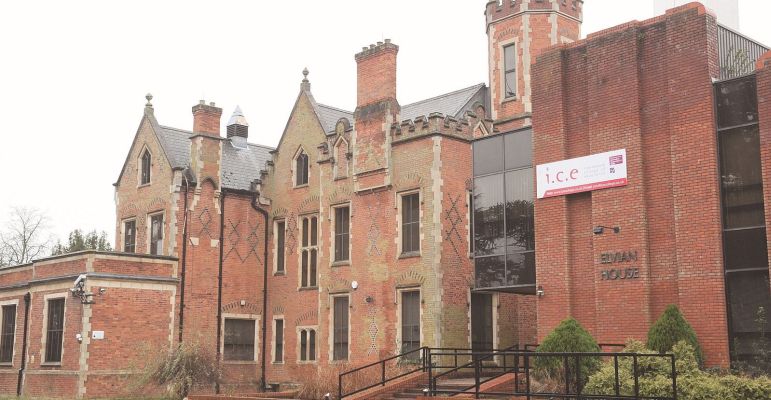
References
Unless otherwise stated, all newspaper articles can be found at the British Newspaper Archive.
The article “Landmark Building Destroyed by Fire” was found at the Slough Express website, in the issue dated Sunday 18th December 2011.
Credits
The photograph of the southern face of Elvian House appears by kind permission of Michael Day and Slough History Online.
The photograph of Queen Mary at the opening of the Princess Alice Home for Totally Disabled Sailors and Soldiers appeared in the Dundee Evening Telegraph of 14th May 1919. It is © by D.C. Thomson & Co. Ltd., and was created courtesy of THE BRITISH LIBRARY BOARD.
The poem “Blacklead Castle” by Keith Bosley from the book “A Chiltern Hundred” (ISBN 0-85646-176-8) is Copyright and appears by kind permission of the publishers, Carcanet Press.
The photograph of the Nixey Close street sign is an edited version of a Street View by Google Maps from July 2014.
The photograph of the front view of Elvian House appears by kind permission of Baylis Media Ltd / Slough Express